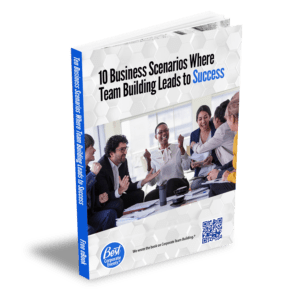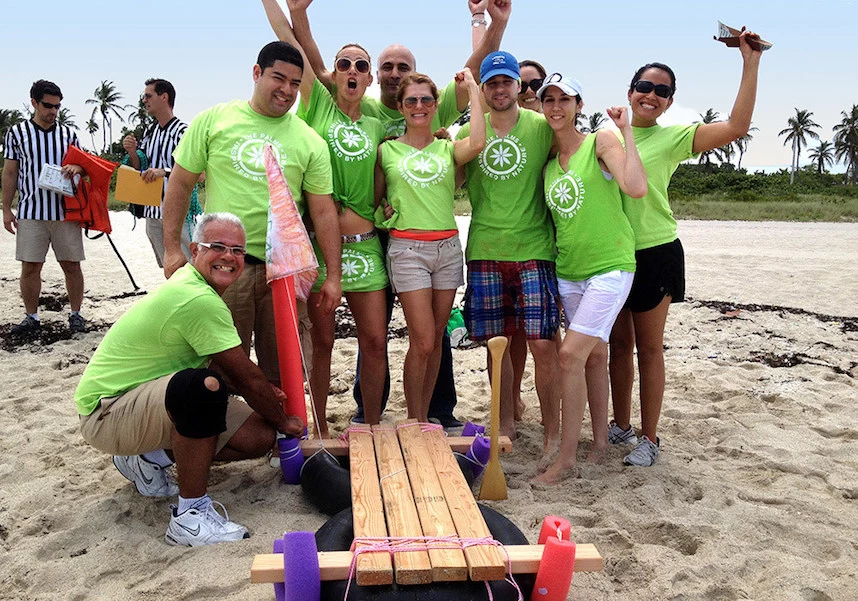Business executives often intuitively understand the value of corporate team building activities. But with multiple competing priorities for limited budget dollars, how can you prove the value of team building? And how can you ensure that you get a positive return?
When you look at the characteristics that high-performing organizations have in common, it’s pretty much a sure thing that a commitment to regular team building events makes the list. Yet not all business leaders are sold on the benefits.
Here’s a look at why some managers may be skeptical about the value of team building, how to set your teams up for success, and how to measure the positive impact of periodic team building exercises.
Does Team Building Work? The Reasons Some are Skeptical
One common reason why managers and employees alike may question the value of team building is that they’ve had a bad team building experience in the past. Perhaps it involved outdated practices like “trust falls.” Or it may have included activities that participants viewed as embarrassing, inappropriate, or even dangerous or too physically demanding.
They may have viewed their team building activity as a waste of time due to a poorly trained facilitator, a bad venue, technical glitches, or even lousy weather for an outdoor event.
Another reason some leaders may be skeptical is they’ve been involved in team building activities that had the wrong goals. Roy Charette, a leader in the fields of team building and professional development training, and managing partner at Best Corporate Events, provided an example.
“I’ve seen this happen. A company brings together 100 salespeople with the goal of teaching them to collaborate and work together as a team. But these sales reps are individuals; they work in silos. Not one of them is going to give away all of their best practices to 99 other salespeople. Every one of them wants to stand out.
“Each one is trying to be the best they can to be compared to all the others, so they get a promotion. Why on earth would they suddenly feel like they should be sharing everything they know with 99 other salespeople whose regions overlap? That’s not going to happen.
“But if it’s managerial training with 30 managers from across the country, who are not competing, there’s no reason for them not to share best practices. I can convince those people in almost no time as to why it’s critically important to avoid forcing colleagues to reinvent the wheel. Best practices get shared because they’re not competing. That’s not true with sales teams who work in overlapping regions.”
A third reason for skepticism is an experience where the goals do not match the activity. Roy supplies another example: “We have activities like A Minute 2 Win It! that are focused on fun competition and fast-paced team collaboration, that can be done in a 60- or 90-minute time slot. It’s a great program for fostering employee engagement, team problem-solving, and continuous improvement.
“But if the goal is to enhance the leadership skills of your management team, and improve their conflict resolution abilities, what you might want is our DiSC Profile Workshop followed by Igniting Team Performance®. 60 minutes of A Minute to Win It! isn’t the right program to accomplish those goals.”
How to Set Up Your Team Building Program for Success
If you’re competing for budget dollars for team building—and especially if you need to convince someone who’s skeptical about its value—it’s vital to present a plan to assure that your team building event is productive. Here are six key steps to running an effective team building activity:
-
Establish clear goals
As management guru Peter Drucker famously said, “You can’t manage what you can’t measure.” The first step in ensuring your team building program is successful is establishing exactly what success for this particular activity will look like. This also helps your team building provider do a better job of advising you on how to accomplish your goals.
-
Get employee buy-in
Even employees who’ve never been part of a high-quality team building experience can get enthusiastic about it once they understand the “what’s in it for me” factor. As noted here previously, employees place a high value on professional development opportunities, which can help them advance in their careers. Make it clear how the activity will positively impact them (besides having fun on work time).
-
Collaborate with your team building program facilitator
The better you prepare your employees for the event (see the point above), and the more information about your team and your goals you provide to the facilitator, the more likely it is that your program will be successful. Treat the facilitator as your partner in delivering a positive and productive team building experience.
-
Match the activity to your objectives
As noted above, different activities work best for specific groups and goals. Team building programs like Pipeline and Momentum are ideal for enhancing communication, team problem-solving, and collaboration. Corporate social responsibility (CSR) programs add the element of community service, which creates a powerful shared emotional experience.
-
Choose the right venue
While the outdoors can be tempting, particularly at certain times of the year, it’s vital to choose a venue that will create the best environment for success. That means adequate space, a good sound system, comfortable surroundings, and minimal distractions.
Last, but by no means least, it’s critical to choose the right team building partner. While there are many considerations when choosing a team building program facilitator, five crucial elements to look for are:
-
Assessment
This is where a positive and productive experience begins. Before making any specific recommendations, your program facilitator should ask a lot of smart questions to help understand your needs and customize your activity. These range from the basics (group size, venue, time allotted) to really understanding your objectives and any big recent changes within your company (merger, reorganization, new product launch, etc.).
-
Debriefs
The assessment and debrief serve as sort of the bookends for your team building exercise. As the assessment helps position the event for success at the beginning, a quality debrief wraps up the activity at the end: reiterating lessons, reinforcing key concepts, and gathering team feedback.
-
Infrastructure
Make sure your provider has the business structure in place to support your event. Will the facilitator arrive before your event to make sure everything is ready to go? Do you have a dedicated project manager?
If you are doing a CSR event such as a Bike Build Donation® or a Build-a-Wheelchair® activity, does your team building provider have a warehouse with the kits in stock, ready to ship—as well as a charity department to work with a local nonprofit to accept the donation? It all matters.
-
Experience
Make sure the provider you choose has relevant experience in terms of your city, your industry, and your group size. As Roy Charette adds, “I’ve been doing this full-time since 1996. I explain to clients that they aren’t paying for three hours of our time—they’re paying for 27 years of working to get it right. I’ve made every mistake possible, with other people and in the past, so I tell clients now they’ll be happy to know they are on the right end of those 27 years.”
-
Client reviews
There’s no better authority on the quality of your provider than the organizations that have already worked with them. Along with the other characteristics above, look for a large number of 5-star ratings.
7 Methods for How to Measure Team Building Success
So, having done what you can to set up your team building event—or better, your ongoing team building program—for success, how do you measure the return on your investment in employee time and company dollars? Here are seven key methods.
-
Ask for feedback
Collect event-specific feedback from your team immediately following the activity. Did they feel the exercise was worthwhile? What were their key takeaways? Was there anything about the event they wish had been done differently? How will it impact their work going forward? Did they have fun?
-
Survey employees on an ongoing basis
Again, high-performing organizations typically make team building an ongoing activity and priority. While every event should be productive, the real impact emerges over time.
Conduct anonymous employee surveys periodically, asking about job satisfaction, engagement, communication, culture, collaboration, and productivity. Look for positive trends over time, as well as spotting areas of concern to address and goals for upcoming team building events.
-
Monitor employee retention rates
Track employee retention rates as well as absenteeism, and changes over time. Regular team building should improve engagement and attendance while lowering recruitment and onboarding costs.
-
Measure customer satisfaction
Happy employees make for happy customers. Customer satisfaction can reduce customer churn, lower your cost of sales, and increase revenue.
-
Look at project management metrics
Successful team building should lead to improvements in projects completed on time, within budget, and delivering the planned benefits.
-
Watch department-specific measures
Depending on which groups are participating in team building exercises, look for improvements in sales productivity, on-time shipping performance, customer service performance, or other department-level metrics.
-
Track financial performance
Ultimately, ongoing team building activities should lead to increased sales and profitability. There are, of course, many factors that go into this which have nothing to do with team building, such as the overall state of the economy. Still, after accounting for those inputs, team building should, over time, improve collaboration, increase productivity, and raise employee satisfaction—all of which contribute to lower costs and higher margins.
So, Does Team Building Work, and Can You Measure Its Success?
Professional corporate team building programs deliver tangible business benefits through improved communications, workplace relationships, and employee engagement.
Though there are leaders who remain skeptical of the value of team building—often due to bad past experiences—a regular cadence of team building activities is common across high-performing organizations.
To help ensure successful team building events, managers should take steps such as establishing clear goals, choosing an appropriate venue, and selecting an expert team building partner.
The positive impacts of team building can be measured in several ways, from employee survey results and project-level metrics, to customer satisfaction, and ultimately, to improved enterprise financial performance.






